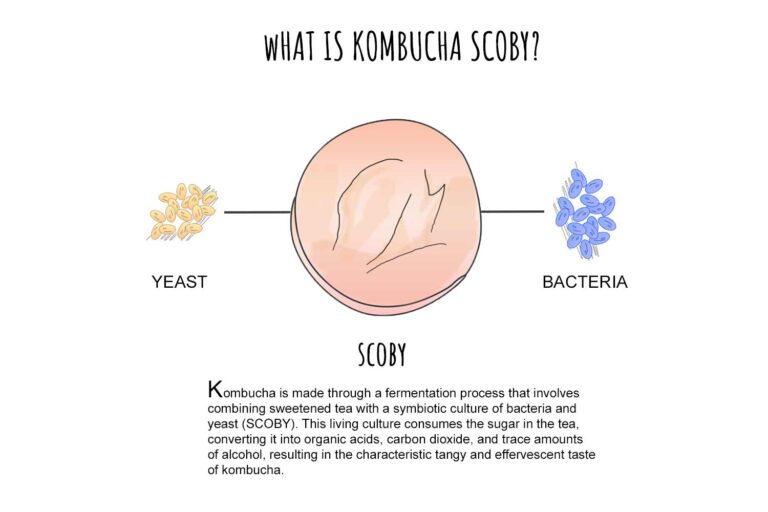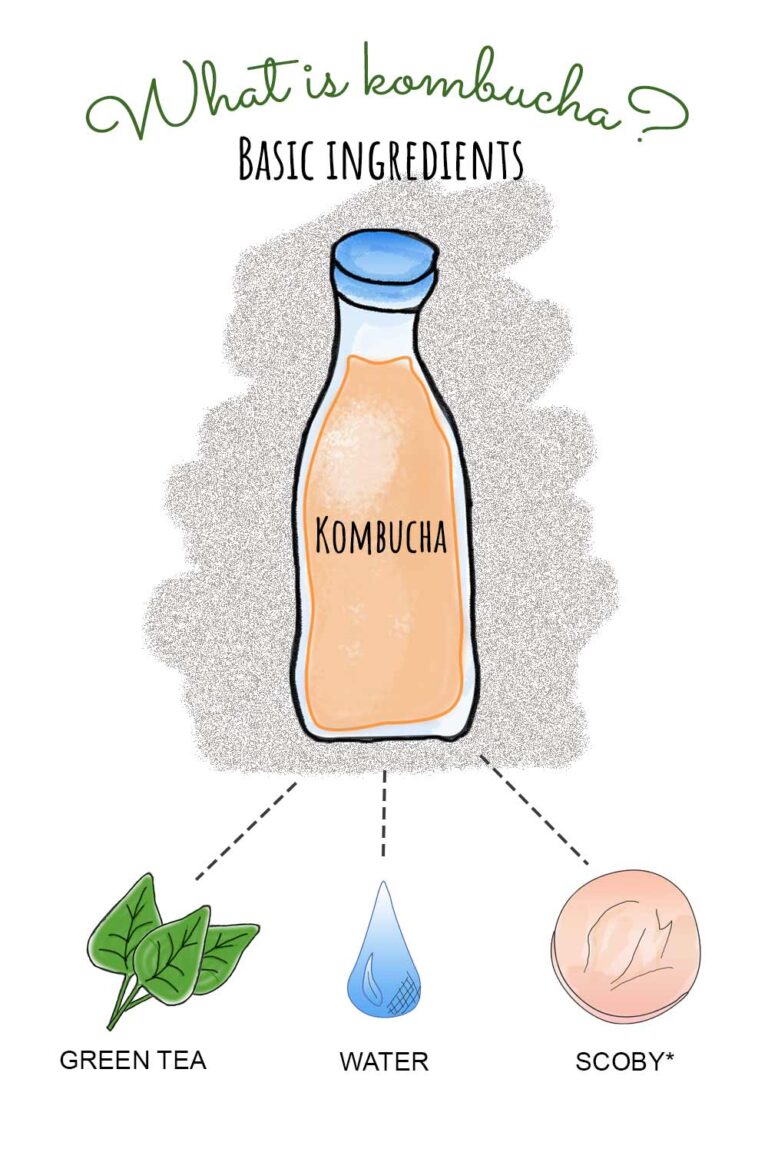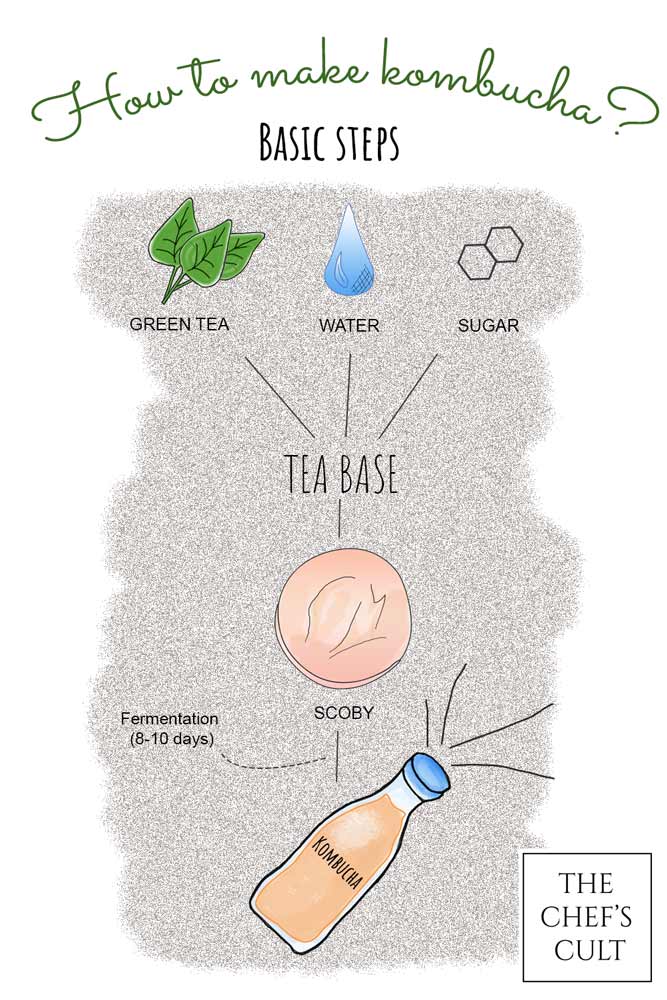In a world where fizzy drinks and sugary sodas dominate the beverage scene, a peculiar elixir has quietly gained a cult following: Kombucha. This effervescent and tangy drink, with its origins shrouded in mystery, has captivated the taste buds and piqued the curiosity of health-conscious individuals and flavor adventurers alike. Join me on a journey to unravel the captivating world of kombucha – a delightful brew that’s as intriguing as it is delicious.
Where does kombucha come from?
Kombucha’s history stretches back over two millennia, and its origins are steeped in legend. According to some accounts, the Chinese Emperor Qin Shi Huang sent emissaries on a quest to discover the secrets of immortality. They returned with a unique fermented tea known as “The Tea of Immortality” – which we now recognize as kombucha. While immortality remains elusive, the drink has certainly earned its place in the annals of history as a mystical brew with remarkable properties.

What is kombucha SCOBY?
At the heart of every kombucha brew lies a strange, otherworldly-looking entity – the SCOBY, short for “Symbiotic Culture Of Bacteria and Yeast.” Often referred to as the “mother,” this gelatinous disc is responsible for the fermentation process that transforms sweet tea into the fizzy, tangy goodness we know and love. As bizarre as it may appear, the SCOBY is a living community of microbes working in harmony to produce this magical elixir.
Brewing kombucha
Brewing kombucha is an art that balances science and creativity. As homebrewers experiment with various teas, sugars, and flavorings, they orchestrate an intricate dance between bacteria and yeast. The brewing process involves several stages, from the initial fermentation to the secondary flavoring, which introduces a kaleidoscope of tastes and aromas. However, mastering the art of kombucha brewing also requires vigilance to avoid any unexpected mishaps, such as over-fermentation turning a fizzy delight into a vinegar bomb!

How is kombucha made?
Kombucha is made through a fermentation process that involves combining sweetened tea with a symbiotic culture of bacteria and yeast (SCOBY). This living culture consumes the sugar in the tea, converting it into organic acids, carbon dioxide, and trace amounts of alcohol, resulting in the characteristic tangy and effervescent taste of kombucha. Here’s a step-by-step guide to how kombucha is made:
Ingredients:
Tea: Usually black or green tea, but other types like white or fruit tea can be used.
Sugar: Provides food for the SCOBY during fermentation.
SCOBY: The living culture responsible for the fermentation process.
Starter liquid: A bit of already fermented kombucha that helps kick-start the fermentation.
Flavorings (optional): Fruits, herbs, or spices can be added for additional taste and aroma.
1. Brewing the Tea The first step in making kombucha is to brew a strong tea. Typically, black or green tea is used, but you can experiment with different types to find your preferred flavor. Boil water and steep the tea leaves for the recommended time (usually 5-7 minutes). Then, add sugar to the hot tea and stir until it dissolves. The sweetened tea acts as the nutrient base for the SCOBY during fermentation.
2. Cooling the Tea Once the tea has steeped and the sugar has dissolved, remove the tea bags or strain the leaves, and let the tea cool to room temperature. It’s essential to allow it to cool completely, as hot tea can harm the SCOBY.
3. Adding the SCOBY and Starter Liquid In a clean glass container, combine the cooled sweet tea with the SCOBY and starter liquid. The SCOBY is usually a flat, rubbery disk, while the starter liquid is a bit of already fermented kombucha, which helps lower the pH and create an acidic environment that inhibits harmful bacteria.
4. Fermentation Cover the container with a clean cloth or coffee filter and secure it with a rubber band to allow airflow while keeping out debris and insects. Place the container in a warm and dark spot, such as a cupboard or pantry. The fermentation process usually takes around 7 to 14 days, depending on the temperature and desired taste.
5. Taste Testing Throughout the fermentation process, you can taste the kombucha using a clean spoon. As the fermentation progresses, the kombucha becomes more acidic and less sweet. When it reaches the desired level of sweetness and tanginess, it’s ready to be bottled. If you prefer a sweeter taste, ferment it for a shorter time; for a more tart flavor, ferment it longer.
6. Bottling and Flavoring (Optional) Carefully remove the SCOBY from the liquid and set it aside along with some of the fermented kombucha to use as a starter for the next batch. The rest of the liquid can be transferred into bottles for a second fermentation, which creates natural carbonation. At this stage, you can add flavorings like fruits, herbs, or spices to the bottles for extra taste and aroma.
7. Second Fermentation (Optional) Seal the bottles tightly and let them sit at room temperature for another 1 to 3 days. During this time, carbonation develops as the remaining sugars are consumed by the yeast. Be cautious, as the pressure can build up in the bottles, so it’s essential to “burp” them by slightly opening the cap to release excess gas.
8. Refrigeration and Enjoyment After the second fermentation, transfer the bottles to the refrigerator to halt the fermentation process and enjoy your homemade, fizzy, and flavorful kombucha!
Remember, when brewing kombucha at home, it’s essential to maintain a clean and sanitary environment to prevent contamination. Additionally, always handle the SCOBY and fermented liquid with clean hands and utensils to maintain the health of the culture and produce a delicious and safe batch of kombucha.

The health benefits of kombucha
Kombucha has earned a reputation as a health elixir, credited with an array of potential benefits, ranging from improved gut health to boosted immunity. While some studies support these claims, it’s crucial to separate the facts from the hype. Probiotics, organic acids, and antioxidants are among the key components contributing to kombucha’s potential health advantages. However, it’s essential to consume it in moderation and be mindful of added sugars and alcohol content, especially in commercially produced versions.
Flavors and kombucha variations
Beyond its purported health benefits, kombucha tantalizes the taste buds with a wide array of flavors. Classic kombucha boasts a tangy, slightly sweet profile, but innovative brewers have elevated this ancient brew to an art form. From exotic fruit blends to herb-infused concoctions and even savory varieties, the flavor possibilities seem endless. Embarking on a kombucha tasting journey can be both enlightening and adventurous, as each sip transports you to a realm of taste sensations.
Kombucha – the rising star
In recent years, kombucha has transitioned from a niche health drink to a mainstream trendsetter. Its growing popularity has led to its appearance in popular culture, making its way into movies, TV shows, and even celebrity social media accounts. Influencers and wellness enthusiasts praise it as a must-have beverage, while mixologists and chefs incorporate it into creative recipes, such as kombucha-based cocktails and salad dressings.
The kombucha lovers
Kombucha’s rise to fame has sparked a tight-knit community of enthusiasts who share their brewing adventures, flavor experiments, and SCOBY secrets online and at local meetups. Homebrewing workshops, kombucha festivals, and friendly competitions bring together tea fanatics and health aficionados, fostering a sense of camaraderie among those enchanted by the magic of kombucha.
As we bid adieu to the enigmatic world of kombucha, we leave with a greater appreciation for this captivating elixir. From its mystical beginnings to its transformation into a mainstream trendsetter, kombucha’s journey is a testament to the wonders of human curiosity and creativity. Whether you seek to improve your health or simply indulge in the endless flavors of this effervescent drink, kombucha promises a delightful experience, one fizzy sip at a time. So, go ahead, raise your glass, and join the ever-expanding circle of kombucha enthusiasts – cheers to the magic of fermented tea!


